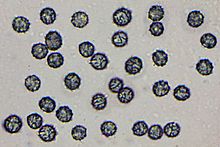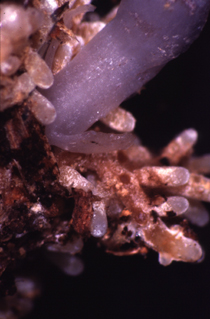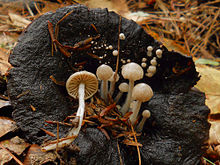Russulaceae
1including Arcangeliella, Gastrolactarius, and Zelleromyces 2including Cystangium, Gymnomyces, Elasmomyces, Martellia, and Macowanites The Russulaceae are a diverse family of fungi in the order Russulales, with roughly 1,900 known species and a worldwide distribution.
In addition to these typical agaricoid forms, the family contains species with fruitbodies that are laterally striped (pleurotoid), closed (secotioid or gasteroid), or crust-like (corticioid).
[1] A prior usage of "Russulariées" by French mycologist Ernst Roze in 1876[5] is not considered a valid publication, since the proper Latin termination for the family rank specified in article 18.4 of the nomenclature code was not used.
[4][6] Synonyms of Russulaceae include: Ernst Albert Gäumann's Lactariaceae (1926), Fernand Moreau's Asterosporaceae (1953),[2] and David Pegler and Thomas Young's Elasmomycetaceae (1979).
The latter family was proposed to contain species with statismosporic (non-forcibly discharged) and symmetric spores, including the gasteroid genera Elasmomyces, Gymnomyces, Martellia, and Zelleromyces.
Calonge and Martín reduced the Elasmomycetaceae to synonymy with the Russulaceae when molecular analysis confirmed the close genetic relationship between the gasteroid and agaricoid genera.
[2][8][9] The use of molecular phylogenetics confirmed that these morphologically diverse fungi form a distinct lineage, first termed the "russuloid clade"[10][11] and today classified as order Russulales in the class Agaricomycetes.
[13] Lactarius Multifurca Russula Lactifluus Boidinia Gloeopeniophorella Pseudoxenasma A 2008 molecular phylogenetic study clarified the relationships among the mushroom-forming species of the family.
[15] The authors demonstrated the existence of four distinct lineages of gilled mushrooms, which led to the description of Multifurca as a new genus separated from Russula[15] and the segregation of Lactifluus from Lactarius.
[16][17] Genera with closed fruitbodies within the family are form taxa instead of natural groups: Arcangeliella, Gastrolactarius, and Zelleromyces are phylogenetically part of Lactarius, while Cystangium, Elasmomyces, Gymnomyces, Macowanites, and Martellia belong to Russula.
[18] The crust-like genera Boidinia, Gloeopeniophorella, and Pseudoxenasma, formerly placed in the Corticiaceae or Gloeocystidiellaceae, are now classified in the Russulaceae and basal to the clade of mushroom-forming species described above.
The agaricoid species in Lactarius, Lactifluus, Multifurca, and Russula are readily distinguished from other gilled mushrooms by the consistency of their flesh, which is granular, brittle and breaks easily, somewhat like a piece of chalk.
[3][25][40] The corticioid species of Boidinia, Gloeopeniophorella, and Pseudoxenasma develop crust-like fruitbodies with a smooth, porous, or flaky surface and grow on tree logs or dead branches.
[14] The feature responsible for the brittle fruitbody structure in the mushroom-forming species are globular cells, called sphaerocytes or sphaerocysts, that compose the flesh (trama) alongside the usual hyphae.
These are hyphae carrying the "milk" or "latex" exuded by the milk-caps; they react positively with sulfoaldehydes, form an abundantly branched system in the trama and end as pseudocystidia in the hymenium.
[15][19] Species of Lactarius, Lactifluus, and Russula have repeatedly been introduced with trees outside their native range: An overview article lists introductions in Chile, Argentina, Uruguay, Brazil, the US, Great Britain, the Faroe Islands, South Africa, China, Thailand, and New Zealand.
[43] The genera Lactarius, Lactifluus, Multifurca and Russula form a mutualistic ectomycorrhizal root symbiosis with trees and shrubs, exchanging mineral nutrients for photosynthetic sugar.
In the tropics, known plant partners include Dipterocarpaceae,[55][72] Fabaceae,[35][72] Nyctaginaceae,[73][74] Phyllanthaceae,[72] Polygonaceae (Coccoloba),[74] Sarcolaenaceae,[75] and the gymnosperm Gnetum gnemon,[76] and in the Southern Hemisphere, Nothofagaceae,[58][59][77] Myrtaceae (Eucalyptus[57] and Leptospermum),[58][77] and Rhamnaceae (Pomaderris).
[59][77][78] Where they are introduced, they typically grow in plantations of their native host species, e.g. with pine in South Africa,[87] Eucalyptus in Thailand,[88] or birch in New Zealand.
A mutualistic association similar to ectomycorrhiza but with some hyphae penetrating into the plant root cells, termed arbutoid mycorrhiza,[89] is formed by Russulaceae with shrubs of the genera Arbutus[83] and Arctostaphylos,[90] both in subfamily Arbutoideae of the Ericaceae.
[100] Fruitbodies of Lactifluus or Russula species otherwise hot-tasting and unpalatable are regarded as choice edibles in North America when infected by the "lobster mushroom" Hypomyces lactifluorum.
[102] However, national lists contain some species of Lactarius, Lactifluus and Russula, indicating that they have small populations and are endangered, e.g. in Great Britain,[103] Switzerland,[104] the Czech Republic,[105] and New Zealand.
[119] Some species are however truly poisonous: the East Asian and North American Russula subnigricans causes rhabdomyolysis and is potentially lethal,[120] and Lactarius turpis from Eurasia contains a mutagenic substance.
[124] Pigments have been isolated from brightly coloured species, e.g. (7-isopropenyl-4-methylazulen-1-yl)methyl stearate from the blue Lactarius indigo[125] or russulaflavidin and a derivative from the yellow Russula flavida.
[128] Other metabolites isolated from different species include dibenzonaphtyridinone alkaloids,[128] prenylated phenols,[128] benzofurans,[128] chromenes,[128] natural rubber (polyisoprene),[130] sterols,[131] and the sugar alcohol volemitol.




